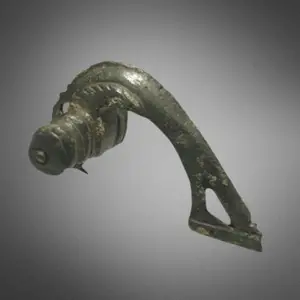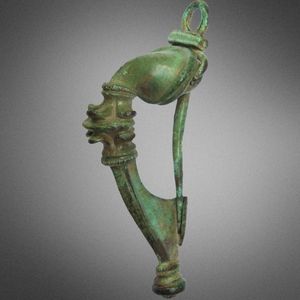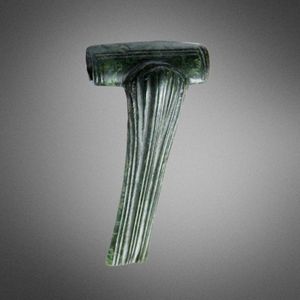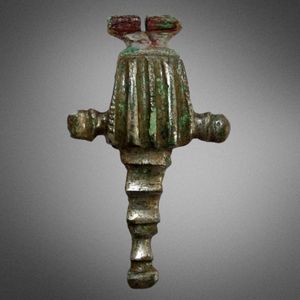Roman brooch identification
If you were to metal detect or even just field walk on some land which had a busy Roman period placed on it, if you looked carefully, you could almost guarantee finding various types of Roman pottery.
Even though they are hard to see with the naked eye, you may even spot the odd Roman coin on the surface. These vary in size and more akin to being found with a metal detector.
(I do have an additional article briefly discussing Roman coins facts here) If you aren’t a metal detectorist but fancy giving it a go, read my article Metal detecting for beginners – where to start.
The next most typical find for metal detectorists hunting on Roman occupied site are Roman brooches or Fibulae as they are known collectively.
There are many different types of Roman brooch which came into fashion at different times of the Roman period so they can be seen as a useful dating tool.

Unbeatable Multi Frequency!
You can now get the ultimate power of multi frequency technology over single frequency detectors with the Minelab Vanquish range of detectors.
The entry level Vanquish 340 now gives you ultimate depth, stability and sensitivity on all target types in every soil, including wet beach sand.
Roman fibula brooch
There are many types of Roman brooch design and it’s easy to get wrapped up in the wonder of how they were made and who may of made them.
Their purpose however was rather mundane and straightforward in that they were made to fasten clothing to prevent cloth separating.
Much like a safety pin of today, it required a pin to pierce through the clothing which would of been sprung or under tension. This would of been attached to the main body of the brooch.
The pins would of either been sprung by being coiled or simply hinged so they swung. A clasp hook at the opposite end of the brooch would retain the pin and secure the clothing.
These brooches and pins would have been under a lot of tension and it would be that in most cases, the pin would break or snap rendering the brooch useless.
These would either then get thrown away or dropped without the wearer knowing until some clothing came apart! Brooches were almost always made of bronze. (Approx 80-90% copper, 10-20% tin)
Some more elaborate brooches would have coloured enamel inlays cast into them. Let’s get into the different types that you might uncover if you were metal detecting!
Roman brooch designs
Nauheim or La Tène III brooch

These are a one piece brooch with a very simple design.
Known as a Nauheim type because of its use in that part of Germany from around 75BC.
These were common in Britain from the start of the 1st Century.
Bow brooch

This type of brooch can have many variations.
These variations can be on the bow or head of the brooch with its wings.
These types can be sprung or hinged.
Polden Hill brooch

Very similar to a “Dolphin” type brooch, the Polden Hill brooch has lateral lugs to carry the axis bar and the familiar “T” shape. (AD50-70)
Head Stud brooch

Head stud brooches are very similar to bow brooches but are distinguished by the head stud at the top of the brooch and the foot knob at the bottom.
These can be sprung or hinged. Both the stud and bow are usually decorated with coloured enamel.
In many cases, at the top of the bow would be a small ring which would have a chain attached to it.
Trumpet brooch

Known as such because the head of the brooch would be shaped into a trumpet which contained the spring for the pin.
Many have rings on the head and would be worn in pairs joined by a chain.
Fantail brooch

Called so by the obviously splay on the bottom of the brooch which looks like a fan or a tail.
These date from the mid 1st Century up to the mid 2nd Century.
Langton Down brooch

This type of brooch is noticable by the main bow being flat and tapered rather than having a solid bow.
Again, there are several variations of this type and they could be sprung or hinged.
Hod Hill brooch

Quite a distinctive brooch by its large head and divisions.
The upper part usually has two projection known as ‘side knobs’. The bottom part is a tapered strip.
This type of brooch can be dated to the early part of the conquest and found on military sites.
It’s name is derived from when they were first found at Hod Hill in Dorset.
Final thoughts
This by no means is an exhaustive list of Roman brooches but merely a brief taster of what interesting things you potentially could find metal detecting. I have some great follow on articles for you to read.
When you find a Roman brooch for the time, and in fact every time after, the fact that you are the first person to hold that brooch for potentially 1,800 years gives you goose bumps!!
Find out more about the best metal detector for a beginner , what is the definition of treasure and how to carry out metal detecting research.

The Evolution Pro Cut
The ultimate accessary for the serious metal detectorist. Super strong, stainless steel specially designed spade.
































